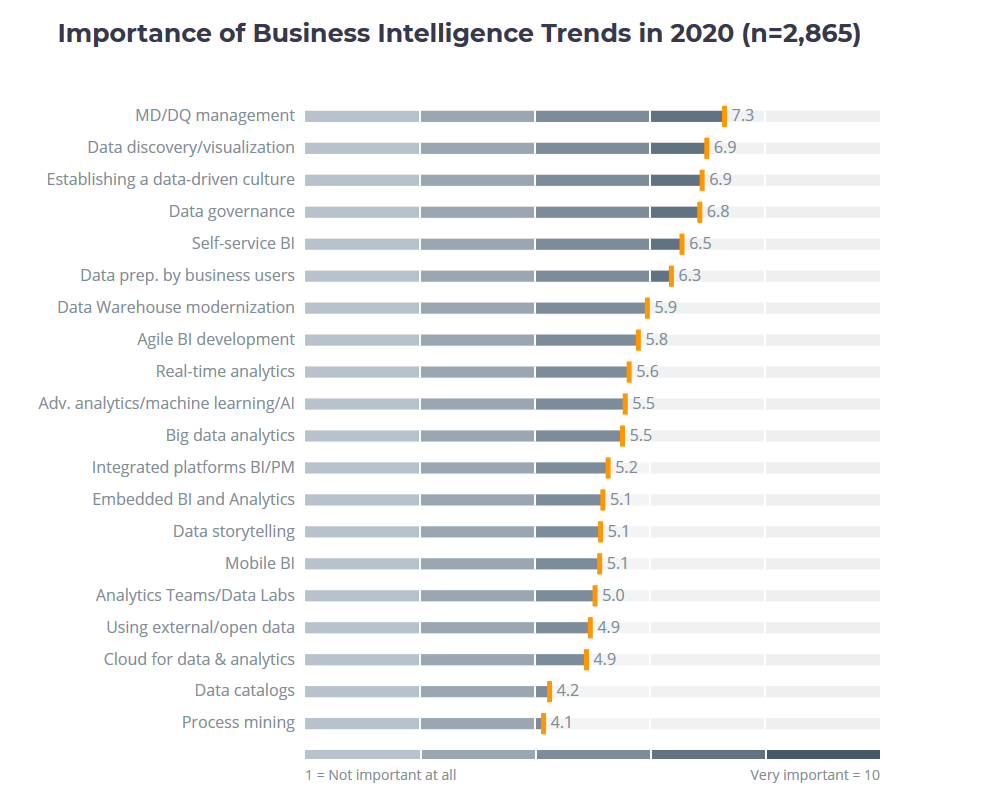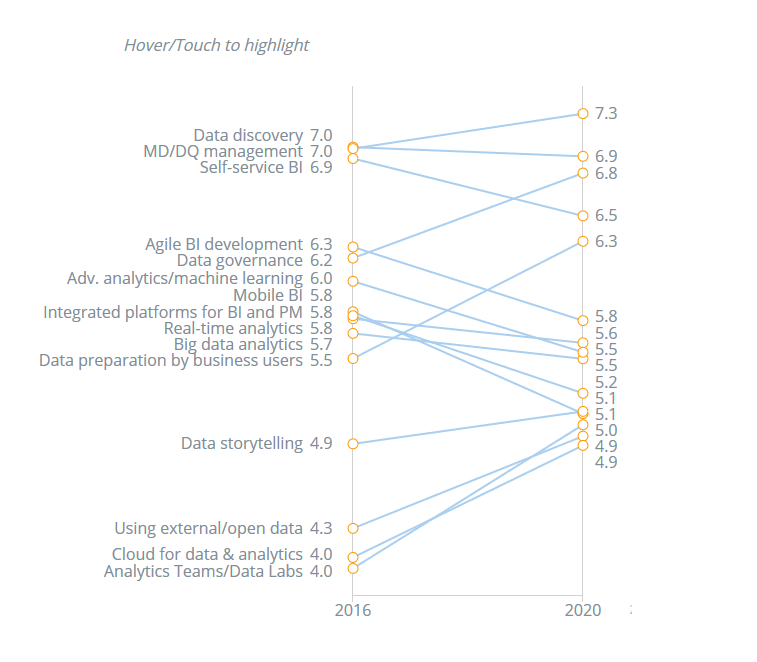Suurimad ärianalüüsi (BI) trendid 2020: Mida 2865 BI spetsialisti tegelikult mõtlevad? (inglise keelne artikkel)
Allikas: bi-survey.com
BCS Itera kommentaar
Viimastel aastatel on ärianalüüs üks kõige kiiremini arenenud valdkondi ja samas ka ettevõtetele kõige enam peavalu tekitav. Selleks on peamiselt kolm põhjust. Esiteks tohutu kiirusega kasvav andmete hulk. Teiseks suutlikkus andmeid analüüsida, mis on üks suur konkurentsieelist andev võimekus. Kolmandaks vahendid ehk pakkujaid ja lahendusi on palju ning küsimus on, mida ja kuidas valida?
Rohkem infot valdkonna ja meie teenuste kohta leiab www.bi365.ee.
Companies are in the midst of many profound changes: The amount of data available and the speed of producing new data has been increasing rapidly for years, and business models as well as process improvements increasingly rely on data and analytics.
Against this backdrop, a key challenge is emerging: the efficient and, at the same time, innovative use of data is only possible when capabilities for – and the operationalization of – both analytics and data management are ensured. Many companies are already reaching their limits with a ‘the more data the better‘ approach and cannot fully leverage the benefits they expect due to a lack of data quality or analytical skills.
In addition, there has been an increased focus on data protection since the GDPR came into effect in 2018. Amid a huge flood of information, companies will have to find ways to handle data in a way that not only complies with legal requirements, but also helps to improve processes and make day-to-day business easier.
This year we asked 2,865 users, consultants and vendors for their views on the most important BI trends. The BARC BI Trend Monitor 2020 illustrates which trends are currently regarded as important in addressing these challenges by a broad group of BI and analytics professionals. Their responses provide a comprehensive picture of regional, company and industry specific differences and offer up-to-the-minute insights into developments in the BI market and the future of BI. Our long-term comparisons also show how trends in business intelligence have developed, making it possible to separate hype from stable trends.
BARC’s BI Trend Monitor 2020 reflects on the business intelligence and data management trends currently driving the BI market from a user perspective.
The Most (and Least) Important BI Trends in 2020
We asked users, consultants and software vendors of BI and data management technology to give their personal rating of the importance of twenty trending topics that we presented to them.
Data quality/master data management, data discovery/visualization and data-driven culture are the three topics BI practitioners identify as the most important trends in their work.
At the other end of the spectrum, cloud for BI and analytics, data catalogs and process mining were voted as the least important of the twenty trends covered in BARC’s survey.
Our View on the Results
While the two most important trends remained the same as last year with master data and data quality management in first position and data discovery in second, third spot is now occupied by establishing a data-driven culture. This trend, which was newly introduced last year and went straight into fifth place in the rankings, is seen as even more important this year. Self-service BI, on the other hand, went down to fifth place this year whereas data governance remains in fourth.
All in all, these five top trends represent the foundation for organizations to manage their own data and make use of it. Furthermore, it demonstrates that organizations are aware of the relevance of high quality data and its effective use. These trends stand for underlying structures being changed: Organizations want to go beyond the collection of as much data as possible and actively use data to improve their business decisions. This is also supported by data warehouse modernization, which is once again in seventh place this year.
Some trends have slightly increased in importance since last year (e.g., real-time analytics and integrated platforms for BI and PM). However, they all climbed just one rank with the exception of establishing a data-driven culture, which jumped two places. Therefore, no huge shift can be observed in terms of upward trends.
The opposite is the case for downward trends: Mobile BI fell from twelfth to fifteenth place this year, continuing its downward trend that started in 2017. It seems as if the mobile application of BI functions is not seen as important anymore, either because it is available now or because requirements have shifted. Advanced analytics/machine learning/AI is ranked one place lower than last year (down from 9 to 10).
More important than the difference of one rank however is the tendency behind this slight downward trend: In 2018, many hopes were based on new tools using machine learning and artificial intelligence so this topic might have been expected to rise. However, even if we refer to it as a stagnation in perceived importance rather than a “real” downward trend, this result is surprising.

